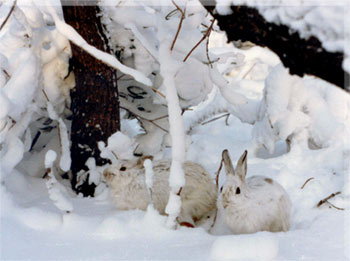Rare, Threatened and Endangered Animal Fact Sheet
Main_Content
Snowshoe Hare | 
Snowshoe Hare, (Lepus americanus)
Photograph by Terry DeWitt | Snowshoe Hares are named for their extraordinary back feet. Extra large feet and long fur on these feet allow the hare to more easily traverse the deep snow of its primarily northern range. This solitary creature prefers to live in mixed spruce-fir forest with an abundant shrub layer for forage in close proximity to a water source, such as a bog, stream or wet meadow. It also inhabits northern conifer swamps and shrub swamps.
In 1986, the Snowshoe Hare was listed as “endangered extirpated” in Maryland, meaning it is still found elsewhere but no longer is it found in Maryland. Snowshoe hares are still found in nearby West Virginia and Pennsylvania. However, populations of Snowshoe Hare in the Appalachians have been in decline as its favored habitat has been degraded or lost, due to multiple causes. Acid Rain, timber harvesting, habitat fragmentation and fire suppression, have all contributed to their decline. So too has the competition for available forage from an increased white-tailed deer population.
It is possible that Snowshoe Hares may still exist in Maryland, especially in remote conifer swamps of Garrett County. Management practices that favor the restoration of conifer forest, especially spruce-fir forest, and encourage preservation of conifer and shrub swamps will benefit this rare hare and other uncommon wildlife and plant species.
|
|
